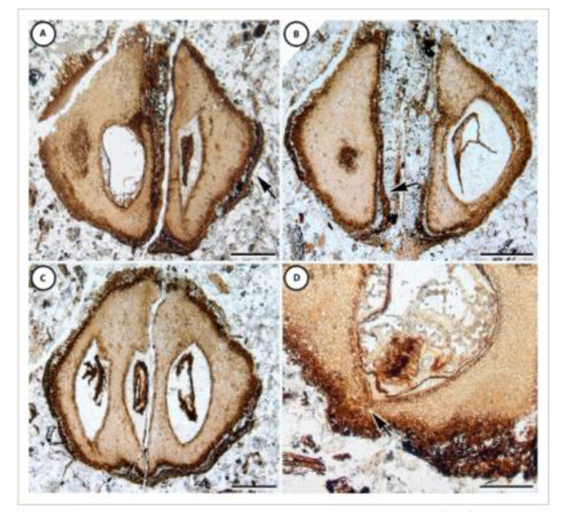Wood You Believe It? Mahogany Dates Back to the Dinosaurs
Canadian Fossil Proves Origins of Mahogany Earlier Than Previously Thought
A fossilised fruit found on a beach in Canada has been identified as having come from a member of the mahogany tree family (Meliaceae). This suggests that this commercially important hardwood evolved in the Cretaceous. The fossil is some 15-20 million years older than any other fossil found that has been ascribed to the Meliaceae. This type of tree would have been familiar to the dinosaurs. Indigenous to the tropics of the Americas, the discovery of this fossil which dates between 79-72 million years ago (Campanian stage of the Late Cretaceous), will support palaeoclimate studies of high latitudes and permit palaeobotanists to better understand how modern tropical, angiosperm dominated ecosystems developed.
Manchestercarpa vancouverensis
The new species of Cretaceous-aged tree has been named Manchestercarpa vancouverensis.
Views of the Fossilised Mahogany Fruit (Manchestercarpa vancouverensis)

Picture credit: Brian Atkinson (University of Kansas)
The picture (above), shows cross-sectional views of the fruit and seeds of the newly described species of Cretaceous mahogany (Manchestercarpa vancouverensis). The thick-walled outer skin of the fruit (endocarp) is identified along with the middle portion, the flesh of the fruit (mesocarp). Evidence of seeds inside the fruit has also been found.
A Significant Fossil Discovery
Today, mahogany is a commercially very important hardwood, valued for its strength and beauty. It is used in cabinet making, furniture and for creating musical instruments. In the days of sailing ships, mahogany was much prized as this tough wood did not splinter as much as European timber when struck by a cannonball. The UK is the world’s second largest importer of mahogany, after the United States. To a palaeobotanist, finding a fossil that is reminiscent of fruit associated with these trees, lets them know that tropical forests similar to the ones we know today were in existence at the time of the dinosaurs.
Prior to this discovery, the oldest fossils attributed to the Meliaceae family date from the Palaeogene and Eocene such as those specimens found in the Green River Formation of Colorado. However, the earliest previously recorded fossils associated with Melia are leaves and scientists have been reluctant to assign these fossils taxonomically. The most diagnostic material are fossil fruits and these fossils have been found in several, geographically dispersed Eocene-aged deposits such as the London Clay and the Nanjemoy Formation of North America.
Geographically Widespread
It seems that in the past, these types of trees and therefore tropical forests were much more widespread than they are today.
Author of the scientific paper, published in the American Journal of Botany, University of Kansas researcher Brian Atkinson stated:
“For understanding when many of the different branches of the tree of life evolved, we’re primarily dependent on the fossil record. In this case, Meliaceae, the mahogany family, is an ecologically and economically important group of trees. A lot of researchers have used this group as a study system to better understand the evolution of tropical rainforests. This work is the first definitive evidence that the tropically important trees were around during the Cretaceous period, when we first start to see the modernisation of ecosystems and modern groups of plants.”
The rock containing the fossilised fruit was found on a beach at Shelter Point, Vancouver (British Columbia), by fossil collector Graham Beard, the director of the Qualicum Beach Museum of Natural History. The matrix in which the fossil was found is associated with the Spray Formation (Campanian faunal stage). The genus name honours palaeobotanist Steve Manchester (University of Florida Museum of Natural History). The species name honours the location of the fossil find.
Fossil Confirms a Cretaceous Origin for the Meliaceae
This paper clearly confirms a Cretaceous origin for Meliaceae and that important tropical families were present prior to the development of modern tropical ecosystems in the Cenozoic.
Graham Beard’s fossil hunting exploits have been featured in this blog before. In 2011, Everything Dinosaur reported upon a paper that had been published naming a new species of Canadian pterosaur (Gwawinapterus beardi), that had been named in his honour. A subsequent study published a year later, confirmed that the fossilised remains attributed to a late-surviving istiodactylid pterosaur actually represented the remains of a fish. To the consternation of the academics associated with this study, it also turned out the Graham had been wrongly accredited with finding the fossil specimen.
To read more: Flying Reptile with “Piranha-like” Jaws the original article.
A second piece correcting the identity of the discoverer: Mistake in Naming Pterosaur Fossil Discoverer.
The scientific paper: “Fossil evidence for a Cretaceous rise of the mahogany family” by Brian A. Atkinson published in the American Journal of Botany.
The Everything Dinosaur website: Everything Dinosaur.

